【漏洞分析】Paraluni 安全事件分析
Paraluni 被黑分析
前言
Paraluni (平行宇宙)是新加坡 Parallel Universe 基金会发布的一个 基于币安智能链的 DeFi 项目,更多相关内容见此处。在 2022 年 03 月 13 日,Paraluni 遭受黑客攻击,损失约 170 万美元。
本次复现是参考学习了各位大佬的复现教程一步一步摸索记录下来的,更多的是对攻击过程中每个步骤的求证(根据这个,我们可以得知它做了什么),而对于一些启发性的思路还有所欠缺(你怎么就知道要看这里?),在文末的引用文章中可以学习一下大佬们的思路。
相关地址
攻击者地址:https://bscscan.com/address/0x94bc1d555e63eea23fe7fdbf937ef3f9ac5fcf8f
攻击交易:https://bscscan.com/tx/0x70f367b9420ac2654a5223cc311c7f9c361736a39fd4e7dff9ed1b85bab7ad54
攻击合约:https://bscscan.com/address/0x4770b5cb9d51ecb7ad5b14f0d4f2cee8e5563645
UBT(ukraine bad token)代币合约:https://bscscan.com/address/0xca2ca459ec6e4f58ad88aeb7285d2e41747b9134
UGT(russia good token)代币合约:https://bscscan.com/address/0xbc5db89ce5ab8035a71c6cd1cd0f0721ad28b508
Masterchef 合约:https://bscscan.com/address/0xa386f30853a7eb7e6a25ec8389337a5c6973421d#code
ParaPair 合约:https://bscscan.com/address/0x3fd4fbd7a83062942b6589a2e9e2436dd8e134d4#code
ParaProxy 合约(代理 Masterchef 合约):https://bscscan.com/address/0x633fa755a83b015cccdc451f82c57ea0bd32b4b4#code
攻击流程分析
首先通过 tenderly 和 blocksec 分析交易过程,可以看到这笔交易的头部和尾部有借款还款操作,可以判断攻击者利用了闪电贷进行攻击。攻击者通过闪电贷贷出了 15w 的 USDT 和 BUSD。
交易的头部,借出代币

交易的尾部,归还代币

然后攻击者调用 ParaRouter.addLiquidity 将 15w 的 USDT 和 BUSD 添加到对应的 ParaPair 合约中,获取流动性代币 LP ,并将其转移到改写了 transferFrom 函数的 ERC20 标准的 UBT 代币合约(0xca2)中。

然后攻击合约(0x477)利用 USDT-BUSD 的 pid 以及 UBT-UGT 代币,通过 ParaProxy 代理的 MasterChef.depositByAddLiquidity 添加流动性。
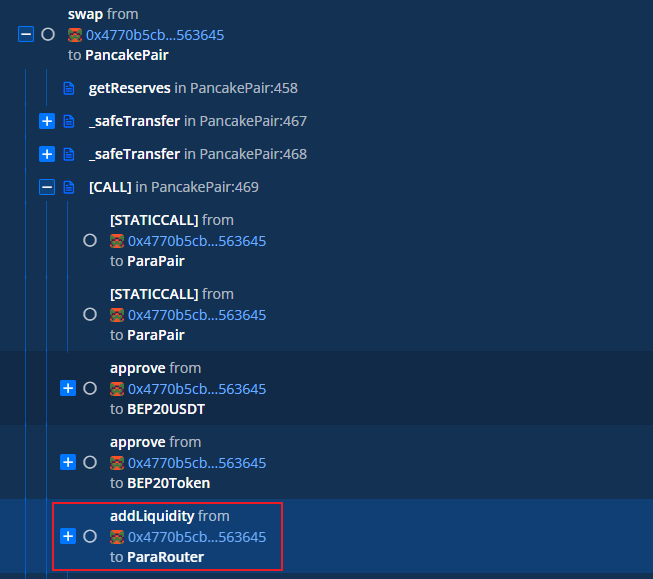
调用 MasterChef.depositByAddLiquidity 函数时的参数输入情况。

MasterChef 合约中的内部调用 depositByAddLiquidity → depositByAddLiquidityInternal → addLiquidityInternal
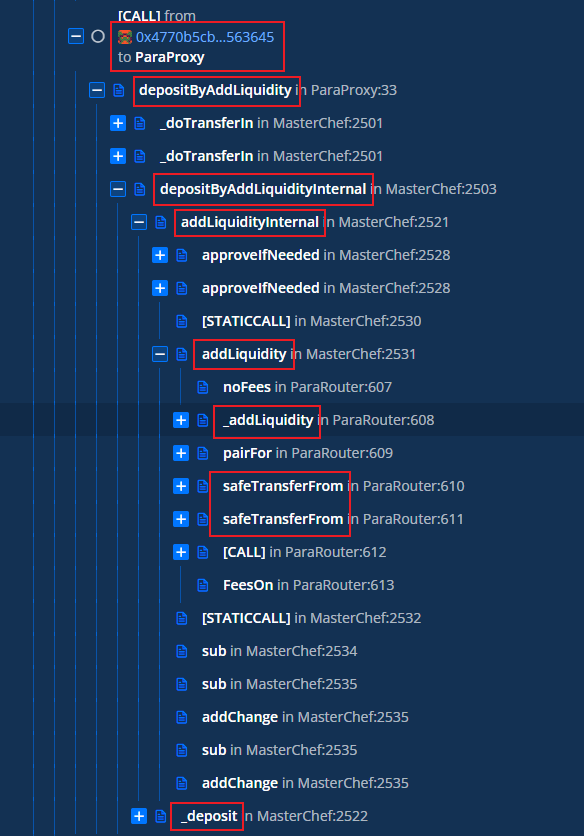
相关函数代码
// MasterChef
function depositByAddLiquidity(uint256 _pid, address[2] memory _tokens, uint256[2] memory _amounts) external{
require(_amounts[0] > 0 && _amounts[1] > 0, "!0");
address[2] memory tokens;
uint256[2] memory amounts;
(tokens[0], amounts[0]) = _doTransferIn(msg.sender, _tokens[0], _amounts[0]);
(tokens[1], amounts[1]) = _doTransferIn(msg.sender, _tokens[1], _amounts[1]);
depositByAddLiquidityInternal(msg.sender, _pid, tokens,amounts);
}
function depositByAddLiquidityInternal(address _user, uint256 _pid, address[2] memory _tokens, uint256[2] memory _amounts) internal {
PoolInfo memory pool = poolInfo[_pid];
require(address(pool.ticket) == address(0), "T:E");
uint liquidity = addLiquidityInternal(address(pool.lpToken), _user, _tokens, _amounts);
_deposit(_pid, liquidity, _user);
}
function addLiquidityInternal(address _lpAddress, address _user, address[2] memory _tokens, uint256[2] memory _amounts) internal returns (uint){
//Stack too deep, try removing local variables
DepositVars memory vars;
approveIfNeeded(_tokens[0], address(paraRouter), _amounts[0]);
approveIfNeeded(_tokens[1], address(paraRouter), _amounts[1]);
vars.oldBalance = IERC20(_lpAddress).balanceOf(address(this));
(vars.amountA, vars.amountB, vars.liquidity) = paraRouter.addLiquidity(_tokens[0], _tokens[1], _amounts[0], _amounts[1], 1, 1, address(this), block.timestamp + 600);
vars.newBalance = IERC20(_lpAddress).balanceOf(address(this));
require(vars.newBalance > vars.oldBalance, "B:E");
vars.liquidity = vars.newBalance.sub(vars.oldBalance);
addChange(_user, _tokens[0], _amounts[0].sub(vars.amountA));
addChange(_user, _tokens[1], _amounts[1].sub(vars.amountB));
return vars.liquidity;
}
// ParaRouter
function addLiquidity(
address tokenA,
address tokenB,
uint amountADesired,
uint amountBDesired,
uint amountAMin,
uint amountBMin,
address to,
uint deadline
) external virtual override ensure(deadline) returns (uint amountA, uint amountB, uint liquidity) {
noFees(tokenA, tokenB);
(amountA, amountB) = _addLiquidity(tokenA, tokenB, amountADesired, amountBDesired, amountAMin, amountBMin);
address pair = ParaLibrary.pairFor(factory, tokenA, tokenB);
TransferHelper.safeTransferFrom(tokenA, msg.sender, pair, amountA);
TransferHelper.safeTransferFrom(tokenB, msg.sender, pair, amountB);
liquidity = IParaPair(pair).mint(to);
FeesOn(tokenA, tokenB);
}
// TransferHelper
function safeTransferFrom(
address token,
address from,
address to,
uint256 value
) internal {
// bytes4(keccak256(bytes('transferFrom(address,address,uint256)')));
(bool success, bytes memory data) = token.call(abi.encodeWithSelector(0x23b872dd, from, to, value));
require(success && (data.length == 0 || abi.decode(data, (bool))), 'TransferHelper: TRANSFER_FROM_FAILED');
}
而攻击点就在于上图框选出来的 safeTransferFrom 函数中。展开来看,UBT 在其 transferFrom 函数中调用了 MasterChef.deposit 函数。
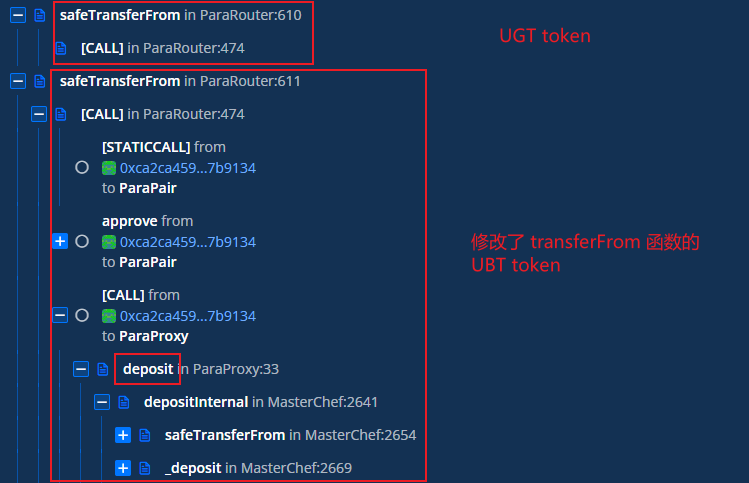
从输入可以得知,UBT 合约的transferFrom 函数通过调用 MasterChef.deposit 将其持有的 USDT-BUSD 的 LP(pid = 18) 全部存入。然后 _deposit 函数记录 UBT 合约(0xca2)存入了 LP 代币。【第一次记录】
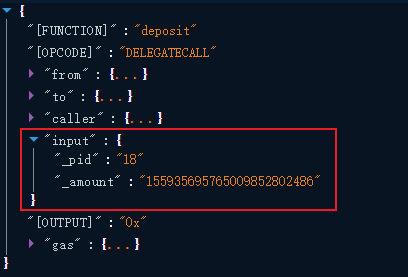
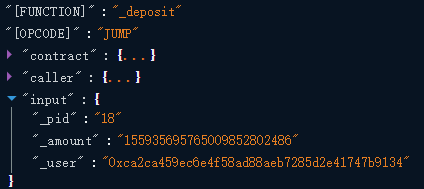
相关的 deposit 代码如下
// MasterChef
function deposit(uint256 _pid, uint256 _amount) external {
depositInternal(_pid, _amount, msg.sender, msg.sender);
}
function depositInternal(uint256 _pid, uint256 _amount, address _user, address payer) internal {
PoolInfo storage pool = poolInfo[_pid];
pool.lpToken.safeTransferFrom(
address(payer),
address(this),
_amount
);
if (address(pool.ticket) != address(0)) {
UserInfo storage user = userInfo[_pid][_user];
uint256 new_amount = user.amount.add(_amount);
uint256 user_ticket_count = pool.ticket.tokensOfOwner(_user).length;
uint256 staked_ticket_count = ticket_staked_count(_user, address(pool.ticket));
uint256 ticket_level = pool.ticket.level();
(, uint overflow) = check_vip_limit(ticket_level, user_ticket_count + staked_ticket_count, new_amount);
require(overflow == 0, "Exceeding the ticket limit");
deposit_all_tickets(pool.ticket);
}
_deposit(_pid, _amount, _user);
}
function _deposit(uint256 _pid, uint256 _amount, address _user) internal {
PoolInfo storage pool = poolInfo[_pid];
UserInfo storage user = userInfo[_pid][_user];
poolsTotalDeposit[_pid] = poolsTotalDeposit[_pid].add(_amount);
updatePool(_pid);
if (user.amount > 0) {
uint256 pending =
user.amount.mul(pool.accT42PerShare).div(1e12).sub(
user.rewardDebt
);
_claim(pool.pooltype, pending);
}
user.amount = user.amount.add(_amount);
user.rewardDebt = user.amount.mul(pool.accT42PerShare).div(1e12);
emit Deposit(_user, _pid, _amount);
}
完成重入攻击以后,函数返回到上一级调用 MasterChef.addLiquidityInternal 处,满足了 _lpAddress 对应的流动性代币增加这一条件。

然后返回到上一级函数, _deposit 函数根据返回的 liquidity 值记录攻击者(0x477)存入了 LP 代币。【第二次记录】

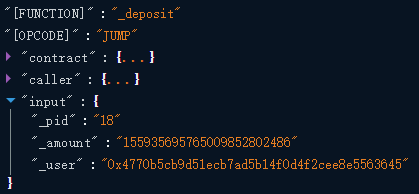
最后就是将手头上的 LP 换取等值的 USDT-BUSD 代币。
UBT 合约先调用 MasterChef.withdraw 函数将存入的 LP 取出,然后发送给攻击合约(0x477)

攻击合约同样先调用 MasterChef.withdraw 函数将存入的 LP 取出,然后调用 ParaRouter.removeliquidity 将价值 31W 的 USDT-BUSD 取走。

最后,归还闪电贷的 15W 代币,然后把剩余代币转账走。
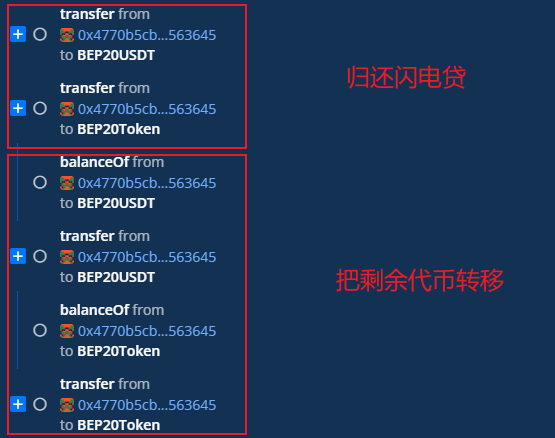
攻击流程
先闪电贷贷 15w 的 USDT 和 BUSD,调用 ParaRouter.addLiquidity 添加流动性,并将获得的 LP 转移到改写了 transferFrom 函数的 ERC20 标准的 UBT 代币合约中
然后利用 USDT-BUSD 的 pid 以及 UBT-UGT 代币,通过 MasterChef.depositByAddLiquidity 添加流动性,内部调用 depositByAddLiquidity → depositByAddLiquidityInternal → addLiquidityInternal
然后 addLiquidityInternal 函数在 paraRouter.addLiquidity 中调用 UBT 代币的 transferFrom 函数进行重入,重入了同合约的 deposit 函数
deposit 函数根据传入的 pid ,将 UBT 代币合约中 USDT-BUSD 的 LP 取走,并为 UBT 合约记录对应的流动性(第一次添加 USDT-BUSD 的 LP)
然后回到 addLiquidityInternal 函数,根据传入的 pid 获取对应的(USDT-BUSD) LP 代币地址,检测添加流动性前后的 LP 差值,并根据差值给攻击合约记录对应的流动性(第二次添加 USDT-BUSD 的 LP)
然后 UBT 合约调用 MasterChef.withdraw 函数将存入的 LP 取出,然后发送给攻击合约。攻击合约同样调用 MasterChef.withdraw 函数将存入的 LP 取出,然后调用 ParaRouter.removeliquidity 将价值 31W 的 USDT-BUSD 取走。
最后,攻击者归还 15w 的闪电贷,并将剩余的 15W 代币进行转移。
总结
本次攻击事件中被利用的漏洞有两处:
MasterChef合约在涉及到流动性操作的时候没有添加重入锁,使得攻击者可以在添加流动性的过程中进行重入攻击。MasterChef.depositByAddLiquidity函数中没有检测_pid与_tokens两个参数是否为对应关系,这使得攻击者可以自定义_token中的函数进行重入攻击。存入的是_token,但是计算的是_pid对应的池子的流动性。

